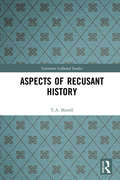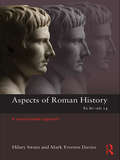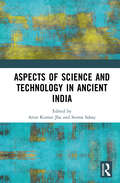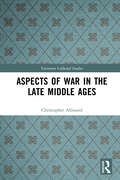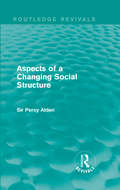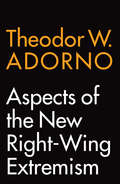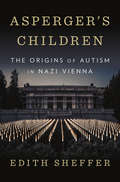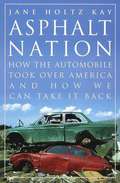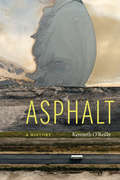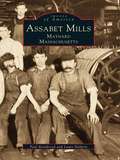- Table View
- List View
Aspects of Recusant History (Variorum Collected Studies)
by T.A. BirrellThomas Anthony Birrell (1924–2011) was a man of many parts. For most of his working life he was Professor of English and American Literature in the University of Nijmegen, The Netherlands, where he was famous for his lively, humoristic and thought-provoking lectures. He was the author of some very popular surveys of English Literature in Dutch, but – first and foremost – he was a bibliographer and a historian. His scholarly oeuvre is extensive and includes such highlights as English Monarchs and their Books (London 1986), a study of the Old Royal Library. However, many of his publications are hidden in occasional publications, periodicals and introductions to books no longer in print. That is why a – posthumous – selection of his bibliographical essays appeared in 2013, entitled Aspects of Book Culture (Ashgate 2013), and that is why it was decided to bring out a companion volume containing a selection of his essays in the field of recusant history. The present edition contains fourteen of Birrell’s articles published between 1950 and 2006. They all demonstrate his bibliographical expertise, his in-depth knowledge of seventeenth- and eighteenth-century English Catholic history and his absolute determination to examine every scrap of archival material that might shed light on the episodes he was investigating. But, perhaps most important of all, he combined his scholarship with an intense interest in the individual lives that shape and are shaped by history, so the lasting impression that these articles will make is the sense of getting close to a whole series of personalities caught up in the turmoil of their time. Aspects of Recusant History was edited by Jos Blom, Frans Korsten and Frans Blom, all three former students of Tom Birrell and, both individually and collectively, authors and editors of a whole range of important book historical publications.
Aspects of Roman History 31 BC-AD 117
by Richard AlstonThis new edition of Aspects of Roman History 31 BC- AD 117 provides an easily accessible guide to the history of the early Roman Empire. Taking the reader through the major political events of the crucial first 150 years of Roman imperial history, from the Empire’s foundation under Augustus to the height of its power under Trajan, the book examines the emperors and key events that shaped Rome’s institutions and political form. Blending social and economic history with political history, Richard Alston’s revised edition leads students through important issues, introducing sources, exploring techniques by which those sources might be read, and encouraging students to develop their historical judgement. The book includes: chapters on each of the emperors in this period, exploring the successes and failures of each reign, and how these shaped the empire, sections on social and economic history, including the core issues of slavery, social mobility, economic development and change, gender relations, the rise of new religions, and cultural change in the Empire, an expanded timeframe, providing more information on the foundation of the imperial system under Augustus and the issues relating to Augustan Rome, a glossary and further reading section, broken down by chapter. This expanded and revised edition of Aspects of Roman History, covering an additional 45 years of history from Actium to the death of Augustus, provides an invaluable introduction to Roman Imperial history, surveying the way in which the Roman Empire changed the world and offering critical perspectives on how we might understand that transformation. It is an important resource for any student of this crucial and formative period in Roman history.
Aspects of Roman History 82BC–AD14: A Source-based Approach
by Mark Everson Davies Hilary SwainAspects of Roman History 82BC–AD14 examines the political and military history of Rome and its empire in the Ciceronian and Augustan ages. It is an indispensable introduction to this central period of Roman History for all students of Roman history, from pre-university to undergraduate level. This is the first book since H.H. Scullard’s From the Gracchi to Nero, published two generations ago, to offer a full introductory account of one of the most compelling and vital periods in the history of Europe. Aspects of Roman History 82BC–AD14: brings to life the great figures of Pompey, Caesar, Antony, Cleopatra and Augustus, and explores how power was gained, used and abused covers the lives of women and slaves, the running of the empire and the lives of provincials, and religion, culture and propaganda offers both a survey of the main topics and a detailed narrative through the close examination of sources introduces students to the problems of interpreting evidence, and helps develop the knowledge and skills needed to further the study of ancient history.
Aspects of Science and Technology in Ancient India
by Arun Kumar Jha and Seema SahayThis book critically examines different aspects of scientific and technological development in Ancient India. It studies the special contribution of the history of science in our scientific understanding and its relationship with the philosophy and sociology of science. The volume: Discusses diverse and wide-ranging themes including Tibetan Buddhist tradition of neuro-biology; Sheds light on the unique developments within iron technology and urbanization in ancient Odisha; Studies the trajectory of proto-historic astronomy in India and the science of monsoon in early India; Evaluates the legacy of Aryabhata based on his major works related to astronomy and mathematics through a multidimensional perspective; Analyses the traditional knowledge of medicine in early India, the golden age of surgery with reference to the ancient Greek and Arabic systems of medicine, and the Buddhist influence on the science of medicine in Tibet. This book will be an essential read for scholars and researchers of ancient history, Indian history, history of science, history of technology, science and technology studies, and South Asian studies.
Aspects of Teeside: Discovering Local History
by Maureen AndersonThe Aspects series takes the reader on a voyage of nostalgic discovery through their town, city or area. This best selling series has now arrived, for the first time, in Teesside. Maureen Anderson has highlighted many wonders of the Teesside area, by using the talent of local authors.In Teesside: A Curious Journey the reader will be given the chance to find out the real boundaries of Teesside, an issue that has caused some controversy. We are then taken to the historical site of Stockton Castle: Gone and Almost Forgotten. There is also the chance to investigate the descent of the people of Teesside in Viking Descent: The Bulmers of Wilton-in-Cleveland Castle. We are also shown how important the waterways can be in River Tees: Lifeblood of the Tees Valley. All these and much more, of Teesside's history, have been captivated with fascinating illustrations in Aspects of Teesside.
Aspects of Urbanization in China: Shanghai, Hong Kong, Guangzhou (IIAS Publications series)
by Gregory BrackenChina’s rise is one of the transformative events of our time. Aspects of Urbanization in China: Shanghai, Hong Kong, Guangzhou examines some of the aspects of China’s massive wave of urbanization – the largest the world has ever seen. The various papers in the book, written by academics from different disciplines, represent ongoing research and exploration and give a useful snapshot in a rapidly developing discourse. Their point of departure is the city – Shanghai, Hong Kong and Guangzhou – where the downside of China’s miraculous economic growth is most painfully apparent. And it is concern for the citizens of these cities that unifies the papers in a book whose authors seek to understand what life is like for the people who call them home.
Aspects of Violence in Renaissance Europe
by Jonathan DaviesInterest in the history of violence has increased dramatically over the last ten years and recent studies have demonstrated the productive potential for further inquiry in this field. The early modern period is particularly ripe for further investigation because of the pervasiveness of violence. Certain countries may have witnessed a drop in the number of recorded homicides during this period, yet homicide is not the only marker of a violent society. This volume presents a range of contributions that look at various aspects of violence from the fourteenth to the seventeenth centuries, from student violence and misbehaviour in fifteenth-century Oxford and Paris to the depiction of war wounds in the English civil wars. The book is divided into three sections, each clustering chapters around the topics of interpersonal and ritual violence, war, and justice and the law. Informed by the disciplines of anthropology, criminology, the history of art, literary studies, and sociology, as well as history, the contributors examine all forms of violence including manslaughter, assault, rape, riots, war and justice. Previous studies have tended to emphasise long-term trends in violent behaviour but one must always be attentive to the specificity of violence and these essays reveal what it meant in particular places and at particular times.
Aspects of War in the Late Middle Ages (Variorum Collected Studies)
by Christopher AllmandThis Variorum collection of articles is intended to illustrate that conflict in the late Middle Ages was not only about soldiers and fighting (about the makers and the making of war), important as these were. Just as it remains in our own day, war was a subject which attracted writers (commentators, moralists and social critics among them), some of whom glorified war, while others did not. For the historian the written word is important evidence of how war, and those taking part in it, might be regarded by the wider society. One question was supremely important: what was the standing among their contemporaries of those who fought society’s wars? How was war seen on the moral scale of the time? The last two sections deal with a particular war, the ‘occupation’ of northern France by the English between 1420 and 1450. The men who conquered the duchy, and then served to keep it under English control for those years, had to be rewarded with lands, titles, administrative and military responsibilities, even (for the clergy) ecclesiastical benefices. For these, war spelt ‘opportunity’, whose advantages they would be reluctant to surrender. The final irony lies in the fact that Frenchmen, returning to claim their ancestral rights once the English had been driven out, frequently found it difficult to unravel both the legal and the practical consequences of a war which had caused a considerable upheaval in Norman society over a period of a single generation.
Aspects of a Changing Social Structure (Routledge Revivals)
by Sir Percy AldenOriginally published in 1937, Aspects of a Changing Social Structure presents lectures delivered in 1936 on behalf of the Sir Halley Stewart Trust. These lectures focus on discussing the interest that government was beginning to take in Britain’s social welfare and industrial patterns. Topics covered include nutrition, child welfare, housing and health in relation to individuals and the state as well as new developments in industrial organisation and the future of the agricultural and coal industry. This title will be of interest to students of Sociology and History.
Aspects of the Mind of Byzantium: Political Theory, Theology, and Ecclesiastical Relations with the See of Rome (Variorum Collected Studies)
by Milton V. Anastos Speros Vryonis Nicholas GoodhueThis volume of studies by the late Milton Anastos contains his major articles published after his previous collection appeared, along with the first publication of a portion of ’The Mind of Byzantium’, Anastos’s projected multi-volume survey of Byzantine intellectual history. These essays deal with the theoretical foundations of Byzantine imperial autocracy, with the formulation of Byzantine theology, and with the often contentious relations between the Churches of Constantinople and Rome. The Byzantine concept of imperial absolutism is shown to have been derived from ancient Greek philosophy and to have persisted unchanged throughout Byzantine history. Other articles focus on the theology of Basil of Caesarea, which is found to be inconsistent with orthodox doctrine in important respects. Last, the relations between the Roman Church and the Eastern Orthodox Church in the Byzantine period are surveyed, with emphasis on the theological and ecclesiological controversies that divided them.
Aspects of the New Right-Wing Extremism
by Theodor W. AdornoOn 6 April 1967, at the invitation of the Socialist Students of Austria at the University of Vienna, Theodor W. Adorno gave a lecture which is not merely of historical interest. Against the background of the rise of the National Democratic Party of Germany, which had enjoyed remarkable electoral success in the first two years after its formation in November 1964, Adorno analysed the goals, resources and tactics of the new right-wing nationalism of this time. Contrasting it with the ‘old’ fascism of the Nazis, Adorno gave particular attention to the ways in which far-right movements elicited enthusiastic support in sections of the West German population, 20 years after the war had ended. Much has changed since then, but some elements have remained the same or resurfaced in new forms, 50 years later. Adorno’s penetrating analysis of the sources of right-wing radicalism is as relevant today as it was five decades ago. It is a prescient message to future generations who find themselves embroiled once again in a struggle against a resurgent nationalism and right-wing extremism.
Aspects of the Theory of Tariffs (Collected Works of Harry G. Johnson)
by Harry JohnsonAn internationally acknowledged authority on all aspects of the theory of international trade and payments, this book collects Harry Johnson’s contributions to the study of international trade, including a critique of the theory of effective protection. The book discusses: the integration of income distribution and other aspects of the economy into the positive theory of tariffs the issues raised by the use of tariffs to promote economic development the implications of distortions of various kinds in the working of competition for tariff theory and policy the costs of protection the implications of effective protection for world economic development and the economic effects of trade preferences the question of free trade and the extent to which it requires the harmonization other aspects of economic policy.
Aspekte der Theorie und Ethik in der Medizin der Antike: Ein Lesebuch
by Johannes RöscheWie wurde in der Antike medizinisch gedacht? Was ist der Nutzen für das Leben und insbesondere für im Gesundheitssystem tätige Menschen? In diesem Buch werden die Verbindungen zwischen medizinischem Denken und Philosophie in der Antike dargestellt. Mit Empedokles und Galen werden bedeutende Persönlichkeiten vorgeführt und davon ausgehend die umfangreiche Tradition medizinischen Denkens in der Antike aufgezeigt. Ebenso werden naturphilosophische Konzepte und Ethik des Corpus hippocraticum beleuchtet. Nicht zuletzt wird im Bereich der Ethik darauf verwiesen, wie ethische Konzepte in allgemeineren philosophischen oder sozialen Systemen verankert sind.
Asperger's Children: The Origins Of Autism In Nazi Vienna
by Edith ShefferA groundbreaking exploration of the chilling history behind an increasingly common diagnosis. Hans Asperger, the pioneer of autism and Asperger syndrome in Nazi Vienna, has been celebrated for his compassionate defense of children with disabilities. But in this groundbreaking book, prize-winning historian Edith Sheffer exposes that Asperger was not only involved in the racial policies of Hitler’s Third Reich, he was complicit in the murder of children. As the Nazi regime slaughtered millions across Europe during World War Two, it sorted people according to race, religion, behavior, and physical condition for either treatment or elimination. Nazi psychiatrists targeted children with different kinds of minds—especially those thought to lack social skills—claiming the Reich had no place for them. Asperger and his colleagues endeavored to mold certain "autistic" children into productive citizens, while transferring others they deemed untreatable to Spiegelgrund, one of the Reich’s deadliest child-killing centers. In the first comprehensive history of the links between autism and Nazism, Sheffer uncovers how a diagnosis common today emerged from the atrocities of the Third Reich. With vivid storytelling and wide-ranging research, Asperger’s Children will move readers to rethink how societies assess, label, and treat those diagnosed with disabilities.
Asphalt Gods: An Oral History of the Rucker Tournament
by Vincent M. MallozziThe real basketball deal–the inside story of Harlem’s legendary tournament and the pros and playground legends who have made it world famous.Earl “The Goat” Manigault. Herman “Helicopter” Knowings. Joe “The Destroyer” Hammond. Richard “Pee Wee” Kirkland. These and dozens of other colorfully nicknamed men are the “Asphalt Gods,” whose astounding exploits in the Rucker Tournament, often against multimillionaire NBA superstars, have made them playground divinity. First established in the 1950s by Holcombe Rucker, a New York City Parks Department employee, the tournament has grown to become a Harlem institution, an annual summer event of major proportions. On that fabled patch of concrete, unknown players have been lighting it up for decades as they express basketball as a freestyle art among their peers and against such pro immortals as Julius Erving and Wilt Chamberlain. X’s and O’s are exchanged for oohs and aahs in one of the great examples of street theater to be found in urban America.Asphalt Gods is a streetwise, supremely entertaining oral history of a tournament that has influenced everything from NBA playing style to hip-hop culture. Now, legends transmitted by word of mouth find a home and the achievements of basketball’s greatest unknowns a permanent place in the game’s record.
Asphalt Nation: How the Automobile Took Over America and How We Can Take It Back
by Jane Holtz KayAsphalt Nation is a major work of urban studies that examines how the automobile has ravaged America's cities and landscape, and how we can fight back. The automobile was once seen as a boon to American life, eradicating the pollution caused by horses and granting citizens new levels of personal freedom and mobility. But it was not long before the servant became the master-- public spaces were designed to accommodate the automobile at the expense of the pedestrian, mass transportation was neglected, and the poor, unable to afford cars, saw their access to jobs and amenities worsen. Now even drivers themselves suffer, as cars choke the highways and pollution and congestion have replaced the fresh air of the open road. Today our world revolves around the car-- as a nation, we spend eight billion hours a year stuck in traffic. In Asphalt Nation, Jane Holtz Kay effectively calls for a revolution to reverse our automobile-dependency. Citing successful efforts in places from Portland, Maine, to Portland, Oregon, Kay shows us that radical change is not impossible by any means. She demonstrates that there are economic, political, architectural, and personal solutions that can steer us out of the mess. Asphalt Nation is essential reading for everyone interested in the history of our relationship with the car, and in the prospect of returning to a world of human mobility.
Asphalt: A History
by Kenneth O'ReillyLa Brea Tar Pits once trapped prehistoric mammals. Today that killer has a chemical cousin in the Athabasca oil sands of Alberta, Canada—immense deposits of natural asphalt destined for upgrading to synthetic crude oil. If the harvesting of this natural asphalt continues unabated, we might find ourselves stuck in a muck of a different kind. Humanity has used asphalt for thousands of years. This humble hydrocarbon may have glued the first arrowhead to the first shaft, but the changes wrought by this material are most dramatic since its emergence as pavement. Since the 1920s the automobile and blacktop have allowed unprecedented numbers of Americans to experience the beauty of their continent from the Adirondacks to the Rockies and beyond, to Big Sur and the Pacific Coast Highway. Blacktop roads, runways, and parking lots constitute the central arteries of our environment, creating a distinct &“political territory&” and a &“political economy of velocity.&” In Asphalt: A History Kenneth O&’Reilly provides a history of this everyday substance. By tracing the history of asphalt—in both its natural and processed forms—from ancient times to the present, O&’Reilly sets out to identify its importance within various contexts of human society and culture. Although O&’Reilly argues that asphalt creates our environment, he believes it also eventually threatens it. Looking at its role in economics, politics, and global warming, O&’Reilly explores asphalt&’s contribution to the history, and future, of America and the world.
Aspiration, Representation and Memory: The Guise in Europe, 1506–1688
by Penny Richards Jessica MunnsExploiting the turbulence and strife of sixteenth-century France, the House of Guise arose from a provincial power base to establish themselves as dominant political players in France and indeed Europe, marrying within royal and princely circles and occupying the most important ecclesiastical and military positions. Propelled by ambitions derived from their position as cadets of a minor sovereign house, they represent a cadre of early modern elites who are difficult to categorise neatly: neither fully sovereign princes nor fully subject nobility. They might have spent most of their time in one state, France, but their interests were always ’trans-national’; contested spaces far from the major centres of monarchical power - from the Ardennes to the Italian peninsula - were frequent theatres of activity for semi-sovereign border families such as the Lorraine-Guise. This nexus of activity, and the interplay between princely status and representation, is the subject of this book. The essays in this collection approach Guise aims, ambitions and self-fashioning using this ’trans-national’ dimension as context: their desire for increased royal (rather than merely princely) power and prestige, and the use of representation (visual and literary) in order to achieve it. Guise claims to thrones and territories from Jerusalem to Naples are explored, alongside the Guise ’dream of Italy’, with in-depth studies of Henry of Lorraine, fifth Duke of Guise, and his attempts in the mid-seventeenth century to gain a throne in Naples. The combination of the violence and drama of their lives at the centres of European power and their adroit use of publicity ensured that versions of their strongly delineated images were appropriated by chroniclers, playwrights and artists, in which they sometimes featured as they would have wished, as heroes and heroines, frequently as villains, and ultimately as characters in the narratives of national heritage.
Aspirations of a Lady's Maid (Breaking the Marriage Rules)
by Eva ShepherdSeparated by classBrought together by passionHaving finally fulfilled her dream of opening a hairdressing parlor, Nellie Regan has no interest in love ruining her plans. After Nellie is caught mocking landowner Dominic Lockhart’s lifeless engagement to Lady Cecily, she’s not expecting him to defend her in a tavern brawl. Now the frustratingly handsome gentleman must recuperate in her home! Close quarters stir simmering attraction…but Nellie’s determined to follow her head, not her heart. Is Dominic willing to do the same?"A very good history, witty and romantic. If this is her first book, I'm waiting for the next one."—Goodreads on Beguiling the Duke
Aspiring Saints: Pretense of Holiness, Inquisition, and Gender in the Republic of Venice, 1618-1750
by Anne Jacobson SchutteWinner of an Honorable Mention in the Professional/Scholarly Publishing Awards given by the Association of American PublishersBetween 1618 and 1750, sixteen people—nine women and seven men—were brought to the attention of the ecclesiastical authorities in Venice because they were reporting visions, revelations, and special privileges from heaven. All were investigated, and most were put on trial by the Holy Office of the Inquisition on a charge of heresy under various rubrics that might be translated as "pretense of holiness."Anne Jacobson Schutte looks closely at the institutional, cultural, and religious contexts that gave rise to the phenomenon of visionaries in Venice. To explain the worldview of the prosecutors as well as the prosecuted, Schutte examines inquisitorial trial dossiers, theological manuals, spiritual treatises, and medical works that shaped early modern Italians' understanding of the differences between orthodox Catholic belief and heresy. In particular, she demonstrates that socially constructed assumptions about males and females affected how the Inquisition treated the accused parties. The women charged with heresy were non-elites who generally claimed to experience ecstatic visions and receive messages; the men were usually clergy who responded to these women without claiming any supernatural experience themselves. Because they "should have known better," the men were judged more harshly by authorities.Placing the events in a context larger than just the inquisitorial process, Aspiring Saints sheds new light on the history of religion, the dynamics of gender relations, and the ambiguous boundary between sincerity and pretense in early modern Italy.
Aspiring Saints: Pretense of Holiness, Inquisition, and Gender in the Republic of Venice, 1618-1750 (The\other Voice In Early Modern Europe Ser.)
by Anne Jacobson SchutteWinner of an Honorable Mention in the Professional/Scholarly Publishing Awards given by the Association of American PublishersBetween 1618 and 1750, sixteen people—nine women and seven men—were brought to the attention of the ecclesiastical authorities in Venice because they were reporting visions, revelations, and special privileges from heaven. All were investigated, and most were put on trial by the Holy Office of the Inquisition on a charge of heresy under various rubrics that might be translated as "pretense of holiness."Anne Jacobson Schutte looks closely at the institutional, cultural, and religious contexts that gave rise to the phenomenon of visionaries in Venice. To explain the worldview of the prosecutors as well as the prosecuted, Schutte examines inquisitorial trial dossiers, theological manuals, spiritual treatises, and medical works that shaped early modern Italians' understanding of the differences between orthodox Catholic belief and heresy. In particular, she demonstrates that socially constructed assumptions about males and females affected how the Inquisition treated the accused parties. The women charged with heresy were non-elites who generally claimed to experience ecstatic visions and receive messages; the men were usually clergy who responded to these women without claiming any supernatural experience themselves. Because they "should have known better," the men were judged more harshly by authorities.Placing the events in a context larger than just the inquisitorial process, Aspiring Saints sheds new light on the history of religion, the dynamics of gender relations, and the ambiguous boundary between sincerity and pretense in early modern Italy.
Assabet Mills: Maynard, Massachusetts
by Lewis Halprin Paul BoothroydThe sleepy town of Assabet Village woke up very quickly when the Assabet Mills was built in 1847. Dams were constructed on the river, millponds were created, and large mills began producing yarn and carpets. Soon the village was turning into a town with stores, churches, schools, and government. As the mill grew, so did the town; the population grew to 7,000 people by 1905. During good times, the mill prospered, but during bad times, it faltered and had to re-invent itself. It had almost as many lives asthe proverbial cat. The carpet mill faltered in 1857, but in 1862, the Assabet Manufacturing Company started producing woolen materials and blankets to support the Civil War. This mill faltered in 1898, but in 1899, the American Woolen Company bought themills and greatly expanded them. In 1950, the woolen company faltered and shut down completely, but in 1957, Digital Equipment moved in. Digital faltered in 1997 and sold the buildings to Clock Tower Place, which is converting the mills into first-class industrial space. Today, the mills are attracting a new set of small industries. This book is filled with images of the various "lives" of the mill complex. Photographs featured within these pages show mill employees at work and at play; workers' homes; the evolution of the mill buildings; and the products produced and sold by the mill. There is even a chapter that shows how wool products are produced.
Assad or We Burn the Country: How One Family's Lust for Power Destroyed Syria
by Sam DagherFrom a Pulitzer Prize-nominated journalist specializing in the Middle East, this groundbreaking account of the Syrian Civil War reveals the never-before-published true story of a 21st-century humanitarian disaster.In spring 2011, Syrian President Bashar al-Assad turned to his friend and army commander, Manaf Tlass, for advice about how to respond to Arab Spring-inspired protests. Tlass pushed for conciliation but Assad decided to crush the uprising -- an act which would catapult the country into an eight-year long war, killing almost half a million and fueling terrorism and a global refugee crisis.Assad or We Burn the Country examines Syria's tragedy through the generational saga of the Assad and Tlass families, once deeply intertwined and now estranged in Bashar's bloody quest to preserve his father's inheritance. By drawing on his own reporting experience in Damascus and exclusive interviews with Tlass, Dagher takes readers within palace walls to reveal the family behind the destruction of a country and the chaos of an entire region.Dagher shows how one of the world's most vicious police states came to be and explains how a regional conflict extended globally, engulfing the Middle East and pitting the United States and Russia against one another. Timely, propulsive, and expertly reported, Assad or We Burn the Country is the definitive account of this global crisis, going far beyond the news story that has dominated headlines for years.
Assassin
by Anna MyersWould you betray your president to win the heart of America's most celebrated actor? Bella isn't evil. But even people with good intentions can end up doing bad things. Especially when they meet people with the power to persuade them to do almost anything, like John Wilkes Booth--the most charismatic and famous actor of his time. So when Booth sets his sights on Bella, an assistant seamstress to Mary Todd Lincoln, to help with his plot to kidnap President Lincoln, he is able to persuade her to betray her president and even turn her back on the boy she has loved her entire life. Bella believes Booth is only trying to force the North to release Southern war prisoners, and will not harm her dear friend Mr. Lincoln. But the kidnapping plot fails, and now Booth will stop at nothing--even if it means harming Bella in the process. Anna Myers has crafted a provocative new look at the Lincoln assassination through the eyes of both a young White House insider and the assassin himself. An author's note provides the historical background to this tragic event.
Assassin of Shadows: A Novel
by Lawrence GoldstoneThe latest historical thriller by New York Times Notable mystery author Lawrence Goldstone plunges readers into the dramatic events surrounding the assassination of President William McKinley.Just after 4 p.m. on September 6, 1901, twenty-eight year old anarchist Leon Czolgosz pumped two shots into the chest and abdomen of President William McKinley. Czolgosz had been on a receiving line waiting to shake the president&’s hand, his revolver concealed in an oversized bandage covering his right hand and wrist. McKinley had two Secret Service agents by his side, but neither made a move to stop the assailant. After he was apprehended, Czolgosz said simply, &“I done my duty.&” Both law enforcement and the press insisted that Czolgosz was merely the tip of a vast and murderous conspiracy, likely instigated by the &“high priestess of anarchy,&” Emma Goldman. To untangle its threads and bring the remaining conspirators to justice, the president&’s most senior advisors choose two other Secret Service agents, Walter George and Harry Swayne. What they uncover will not only absolve the anarchists, but also expose a plot that will threaten the foundations of American democracy, and likely cost them their lives. As in his other brilliant novels combining history and fiction, Lawrence Goldstone creates a remarkable and chilling tableau, filled with suspense and unexpected turns of fate, detailing events that actually might have happened. As Publishers Weekly observed in its starred review of the &“exceptional thriller,&” Deadly Cure, &“Goldstone again blends fact and fiction seamlessly.&”
